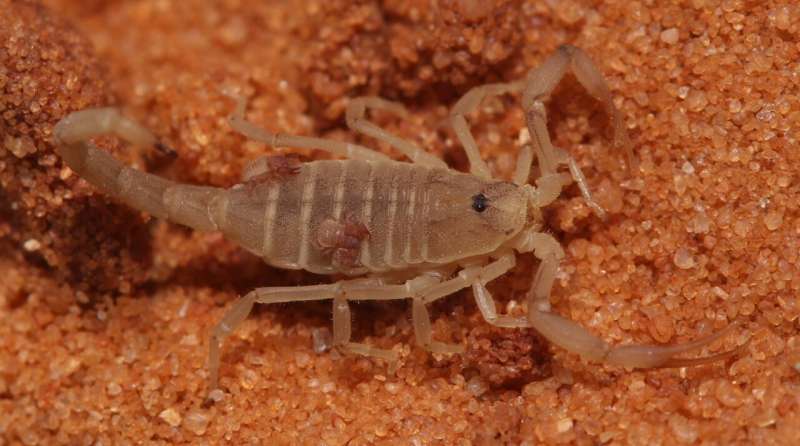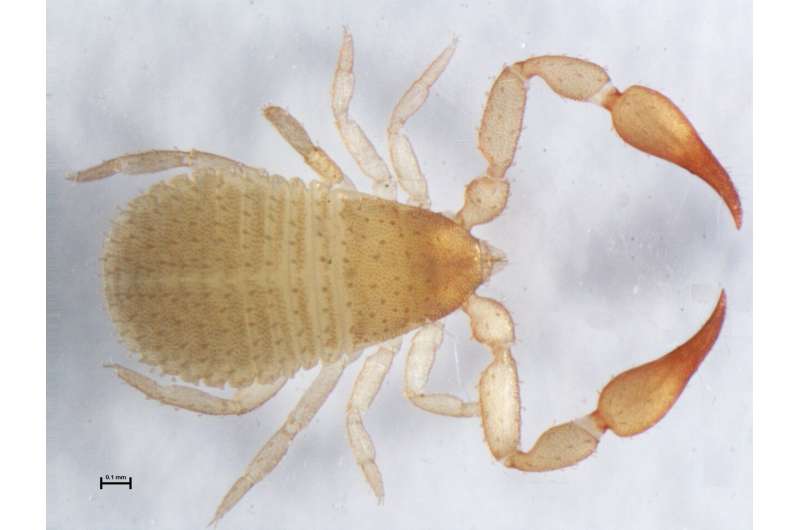This article has been reviewed according to Science X's editorial process and policies. Editors have highlighted the following attributes while ensuring the content's credibility:
fact-checked
trusted source
proofread
Researchers observe tiny pseudoscorpion riding on a scorpion

A recent study led by Yoram Zvik, Dr. Sharon Warburg and Dr. Efrat Gavish-Regev from the National Natural History Collections at The Hebrew University of Jerusalem documented the first observation of phoresy involving a myrmecophile pseudoscorpion on a myrmecophile scorpion.
Phoresy, a well-established phenomenon among pseudoscorpions, involves their attachment to hosts for dispersal into new environments. Documented instances of phoresy include pseudoscorpions attaching themselves to various hosts, ranging from mammals and birds to different insect orders and even other arachnids.
The study focused on pseudoscorpions belonging to an endemic Withiidae species, Nannowithius wahrmani, observed clinging onto the endemic scorpion species Birulatus israelensis in Israel. The research paper, titled "Hitching a ride on a scorpion: the first record of phoresy of a myrmecophile pseudoscorpion on a myrmecophile scorpion," is published in Arachnologische Mitteilungen: Arachnology Letters.
The Withiidae family, encompassing 37 genera and 170 species, has a global distribution, with a significant presence in tropical and sub-tropical regions. Species within the genus Nannowithius, exhibit myrmecophilic tendencies, forming symbiotic associations with ant colonies.
The research focuses on the Nannowithius pseudoscorpions observed on the Birulatus scorpion in Israel, marking the first recorded instance of pseudoscorpions engaging in phoresy on a scorpion host.
As part of his MSc study at the Hebrew University of Jerusalem, at the laboratory of Dr. Gavish-Regev and Prof. Dror Hawlena, Yoram Zvik, now a Ph.D. student at the laboratory of Prof. Eran Gefen, University of Haifa, conducted an extensive seven-year study, involving field surveys, nest monitoring, and observations in the eastern part of Israel. More than 1,000 observations of Birulatus israelensis were documented, with only two observations of the pseudoscorpions species Nannowithius wahrmani on the scorpion's back during specific dates in late spring.

The co-evolution of this phoretic behavior suggests an effective dispersal mechanism, potentially triggered by the high foraging activity of the Messor ants during late spring. The study raises intriguing questions about the cues for dispersion, the co-evolutionary relationship between the pseudoscorpions and scorpions, and the potential benefits of this symbiotic interaction.
This groundbreaking observation not only expands our understanding of arachnid behavior but also opens avenues for future research into the intricate world of symbiotic relationships within the ant nest ecosystem, including how pseudoscorpions elude ants, their alternative hosts, and the cues for both pseudoscorpions and scorpions to disperse.
More information: Sharon Warburg et al, Hitching a ride on a scorpion: the first record of phoresy of a myrmecophile pseudoscorpion on a myrmecophile scorpion, Arachnologische Mitteilungen: Arachnology Letters (2024). DOI: 10.30963/aramit6605
Provided by Hebrew University of Jerusalem


















